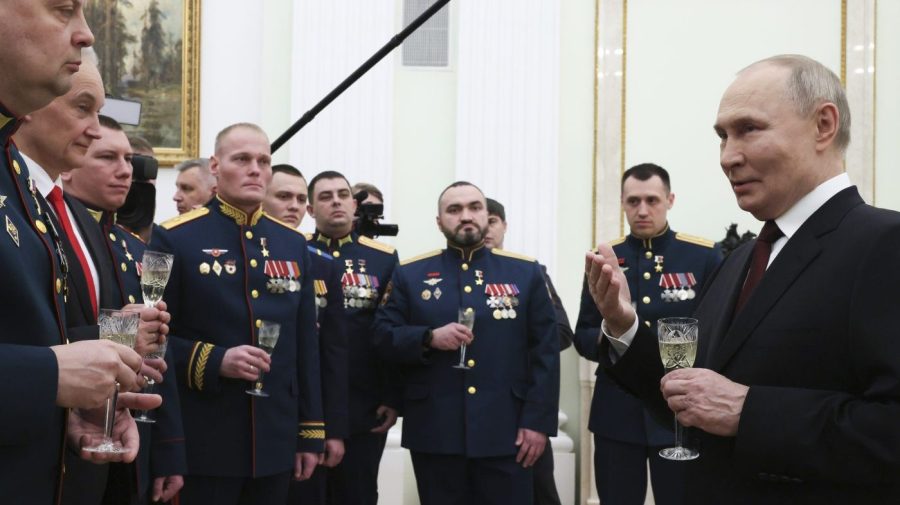
Former President Joe Biden left President Trump a mess in Ukraine, with Russian forces continuing to occupy one-fifth of Ukrainian territory and advancing along the front lines. The U.S. faces diminishing options after three years of deepening entanglement in a brutal war that has devastated numerous Ukrainian cities, towns and villages.
The war has distracted America from pressing challenges in the Indo-Pacific region, the world’s emerging economic and geopolitical hub that is poised to shape the new international order. Worse still, China has emerged as the big winner, as the conflict has ensnared NATO and Russia.
China, significantly stronger than Russia in economic output, military spending and other strategic metrics, remains America’s chief global rival. As Biden’s national security strategy acknowledged, China is committed to achieving global dominance by surpassing the U.S. as the foremost world power.
The U.S.-led “hybrid war” and unprecedented sanctions against Moscow have inadvertently strengthened China’s hand, including by making it Russia’s banker. Russia now conducts much of its international trade in Chinese yuan and deposits the proceeds in Chinese banks, effectively granting Beijing a share in its financial returns.
More concerning is China’s strategic maneuvering to co-opt Russia in an unholy alliance against the U.S. Their “no-limits partnership,” declared in 2022, is creating a two-against-one geopolitical competition that threatens to accelerate America’s relative decline through strategic overreach. A formal Sino-Russian military and strategic alliance could produce a pan-Eurasian colossus — America’s worst geopolitical nightmare.
Given this backdrop, the U.S. needs to return to its old grand strategy, which helped the West win the Cold War by driving a wedge between Moscow and Beijing. Ending the Ukraine war would also enable the U.S. to reallocate military resources from Europe to the Indo-Pacific, where its global primacy is truly at stake.
Trump’s diplomatic outreach to Moscow — aimed at resolving the Ukraine war, as he promised to do in his campaign — has created not only a furor in some Western capitals but also a toxic and divisive political discourse at home. Even before the efforts to end the war have made any tangible progress, Trump already faces fierce criticism. Opponents accuse him of giving Moscow a free pass and endorsing a “Ukraine sellout.” Some claim he has lifted Russia’s international isolation, despite evidence that the West never succeeded in actually isolating Moscow.
But diplomacy between adversaries is crucial to defuse tensions and prevent direct conflict. Biden firmly shut the door to diplomacy with Russia, prolonging Ukraine’s suffering. Only after a change in U.S. leadership did the American and Russian leaders resume direct communication, agreeing to explore pathways to peace.
Ending the Ukraine war will require a complex and carefully negotiated resolution — one that is “enduring, sustainable, and acceptable to all parties,” as Secretary of State Marco Rubio put it. But the political backlash from pro-war factions in the West is making the search for peace even more difficult.
Regardless of how the peace process unfolds, the transatlantic alliance is set for a major transformation. Defense Secretary Pete Hegseth bluntly told European leaders recently to take “responsibility for [their] own security” so that the U.S. can focus on “deterring war with China.” Consequently, tens of thousands of American troops currently stationed in Europe may be redeployed to the Indo-Pacific.
The European Union, which dutifully followed Biden’s lead in escalating the Ukraine conflict through transfers of increasingly sophisticated weapons, now seeks a role in peace negotiations. But the EU is rudderless and deeply divided, grasping for common ground. Its inclusion would be a drag on the negotiations, which may explain why the U.S. and Russian delegations met not in Europe but in Saudi Arabia.
The fact is that the Ukraine conflict remains in many ways a proxy war between Russia and the U.S., with Ukraine caught in the middle — a pawn in the geopolitical chess game. Ukrainian President Volodymyr Zelensky, who has worked to snuff out the country’s nascent democracy through draconian measures, admitted this month that, without America’s continued military aid, it will be “very, very difficult” for Ukraine to “survive.”
By opening direct dialogue with Moscow, the Trump administration has demonstrated both its commitment to ending the war and the marginal role China plays in securing peace in Ukraine. The only nation that benefits from prolonging the war is China, which has more than doubled its nuclear arsenal since 2020 and is expanding its conventional forces faster than any other country has since World War II.
Trump’s decision to extricate America from the Ukraine conflict aligns with long-term U.S. strategic interests. The war, through the flood of Western arms supplies to Kyiv, has exposed the West’s military shortcomings, such as its depleted stocks of critical munitions and air defense systems, as well as America’s struggle to ramp up weapons production.
As Biden himself acknowledged, a “negotiated settlement” is the only viable path to ending the war. A U.S.-Russia peace deal must be reached before Beijing and Moscow can cement a strategic axis that erodes America’s global primacy and increases Taiwan’s vulnerability. A Chinese annexation of Taiwan would reshape the global order, ending America’s global preeminence and undermining its alliance system.
Brahma Chellaney is a geostrategist and the author of nine books, including the award-winning “Water: Asia’s New Battleground.”












